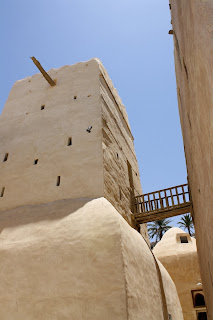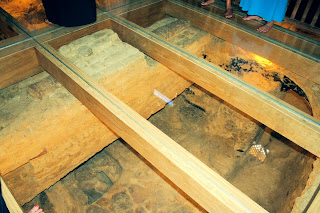The Sinai Peninsula is wedged between Africa and Asia, and is bordered on the north by the Mediterranean Sea and on the south by the Gulf of Aqaba and Suez, and, of course, the Suez Canal. The Sinai Peninsula is also a religious center for the worlds monotheistic religions, and an area that has been a source of conflict for years. From 1967 through 1982, the Sinai Peninsula was under Israeli control. It was returned to Egypt under the provisions of the Camp David Accords.
 |
| One of the Meeting Points for the Camp David Accords along the Suez Canal |
As a result of recent conflicts and tensions within the Middle East, it is quite difficult to gain access to the Sinai Peninsula without the proper permits and such. On our way to the Monastery of St. Catherine, we had to go through five checkpoints and present the required permit and paperwork at each checkpoint. We were even told to carry our passports, in the event they were required at each checkpoint. No one ever asked for our passports, but I think it is because we are in our American bubble. I will save my explanation of the American bubble for later on because I find myself reflecting on it on a daily basis.
Our first stop on the Sinai Peninsula was the Suez Canal. The Suez Canal, a phenomenal feat of engineering when it opened in 1869, separates Sinai from mainland Egypt. In the past, it was a cause of conflict. Today, it is one of Egypt's most important sources of revenue.
 |
| A cargo ship passing through one part of the canal. |
|
As early as the 7th century BC, the ancient Egyptians had connected the Nile and the Red Sea with an east-west canal. A north-south canal, slicing through the Isthmus of the Suez, to connect the Mediterranean with the Red Sea was first considered in the Middle Ages by Venetian merchants. At the end of the 18th century, Napoleon's engineers took up the idea, but dropped it when they mistakenly calculated that one sea was 33 ft. higher than the other. The canal project was taken up by Ferdinand de Lesseps, the French consul to Egypt, who received the go-ahead during the reign of Khedive Said. Construction began on April 25, 1859. If you are a Housewives of New York fan, Ferdinand de Lesseps is the Countess' ex-husband's ancestor. I believe Ferdinand de Lesseps was her ex-husband's uncle, but, nonetheless, they are from the same family!
 |
| Ferdinand de Lesseps' House in Ismailia |
The Suez Canal is not the same as the Panama Canal. The Panama Canal works on a lock system that requires the ship to pulled by tugboats into elevators that will either release water to float the ship lower or increase the water level to float the ship higher. The Suez Canal is just a passage for ships. The Suez Canal can only have one ship passing at one time because it is narrow, so how efficient can it be. Throughout the canal, there are lakes that serve as layover points for the multiple ships that pass through. They usually allow the ships at the Southern end to pass through first because they contain cargo or oil, which is highly flammable, so they want to move those first. The ships on the northern end are usually empty cargo ships, being they made their shipments and are heading back to home ports. The canal is on a very synchronized schedule, so as to avoid any accidents. A ship at the southern end starts moving into the canal first. A ship at the northern end will enter a short period of time later. When the northern ship enters one of the lakes that serve as a layover point, it will drop anchor and wait for the southern ship to pass before it begins moving again. On the whole, it can take up to 18 hours for a ship to pass through the canal.
 |
| Cargo Ship in Lake Suez |
|
The man who forever changed the course history with the Suez Canal was President Gamal Nasser. The cost of building the canal and financing the accompanying lavish celebrations bankrupted Egypt, Khedive Ismail, the ruler under which was completed, was forced to sell his shares and full ownership passed to the French and British who kept control over the canal for the next 80 years. When, in the wake of Egyptian independence, President Nasser nationalized the canal in 1956, Britain and France, in collusion with Israel, invaded the canal zone in an attempt to take it back by force. In the face of widespread international condemnation, they were forced to retreat, leaving the canal in Egyptian hands.
 |
| Caught between two continents - Asia and Africa |
The second part of this lesson will focus on the Monasteries of St. Anthony and St. Catherine, and will also wrap up my lesson on Coptic Christianity. It's too early for me to sound like a teacher right now, but that is what I am told this blog is like, so I guess I will stick with it!
I am so amazed by the Monasteries of St. Anthony and St. Catherine because they are literally in the middle of the desert! I guess when people want to live as hermits, they go to the desert. Let's start with the Monastery of St. Anthony! St. Anthony's is isolated in the Red Sea Mountains, and marks the beginning of the monastic tradition. It is the oldest Coptic monastery in Egypt. Legend has it that Anthony, orphaned at 18, sold all his worldly possessions, gave all the money away, and retreated to the mountains to serve God. His disciples built the monastery on the site of his grave. The monastery is the largest in the country, with several churches and chapels and extensive living quarters, but only 25 resident monks. About a mile northeast of the monastery is the cave where St. Anthony is said to have spent his last years.
 |
| The Monastery of St. Anthony |
 |
Courtyard of St. Anthony's
 |
| The backdrop of the Red Sea Mountains |
A door decorated with religious icons.
Father Maximus showing us the original entrance to the monastery.
For some reason it won't allow me to add captions, so I will tell you what each picture is after the one of Father Maximus, from left to right. The first picture on the left is of a store room that was set-up for sieges. There is no entrance into the building on the left except for the connecting bridge. The picture to the right is a picture of the alter in the church at St. Anthony's. The two pictures that follow right below it are pictures of some of the wall paintings within the church. Look at how vibrant the colors are and the attention to details in the paintings. The next picture is of the crypt below the church. It is actually considered the site of the first church. The last picture is a landscape of St. Anthony's with a backdrop of the Red Sea Mountains.
At the foot of Mount Sinai lies the Greek Orthodox monastery of St. Catherine. It is thought to be the oldest continuously inhabited Christian monastery in the world. Founded in 527 AD by Emperor Justinian, it replaced a chapel built by the Empress Helena in 337 AD on the site where it is believed that Moses saw the Burning Bush.
This is a descendant of the original Burning Bush from which God instructed Moses to lead his people out of Egypt to the Promised Land.
The monastery was renamed St. Catherine in the 9th or 10th century after monks claimed to have found the intact body of the saint on a nearby mountain.
The Entrance to St. Catherine's Monastery
The Walls of Justinian
Who is St. Catherine? St. Catherine was one of the most popular early Christian saints. Supposedly born into a wealthy Alexandrian family in the early 4th century, she was tortured for her Christian beliefs. First, she was spun on a spiked wheel, now known as the Catherine wheel, and then beheaded by the pagan emperor. According to legend, angels carried her body away after her execution. Monks climbing on Mount Sinai found her remains, after hearing of the story of St. Catherine, and built a monastery where her remains were found. A marble sarcophagus in the monastery's Church of St. Catherine contains two silver caskets said to hold part of her remains, found by monks 600 years after he death. I apologize for not having a picture of St. Catherine. No photos were allowed inside the Basilica of Transfiguration or the museum.
View of the Bell Tower
View of the Mosque within St. Catherine's
The mosque was built in 1106 by converting a chapel originally dedicated to St. Basil. It's creation was an attempt to placate local Muslim rulers.
Painted Alter or Niche
The robed skeleton of Stephanos, a 6th century guardian of the path to Mount Sinai. | | |
|
|
| | |
 |
| Charnel House contains the bones of monks who have died here over the centuries. |
 |
| The Well of Moses, where Moses is said to have met his future wife, Zipporah, Jethro's daughter. |
Christianity - Check! Islam is next!

























Nice Post
ReplyDelete